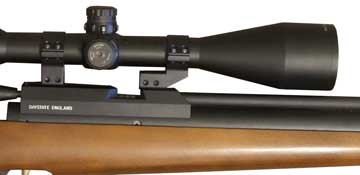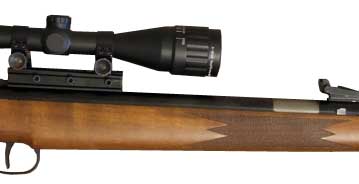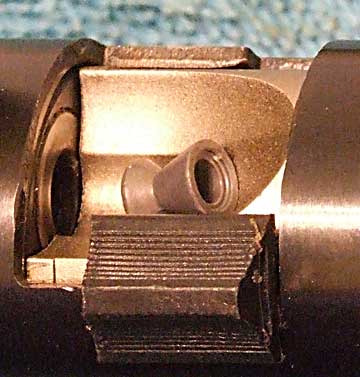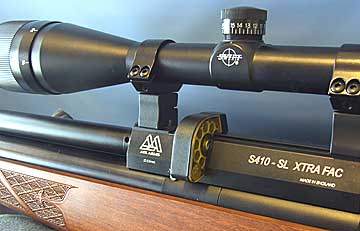by B.B. Pelletier
The first two sections of this report were titled poorly for the way I blog, so I went back and changed their titles to Scopes, Parts 1 and 2. It’s too difficult to track anything else. You may have forgotten, but I’m using this section to write the outline of a book on airgun scope mounting.
Today, I want to look at scope height. How high do you want your scope to be? There are two considerations for scope height. The first is adjusting the height of the exit pupil (the light that comes out of the rear of the scope that lets you see the target and reticle) to the height of your eye and the second is the clearance of the scope above the parts of the gun. Let’s discuss both.
Fit to the eye
Ideally, your rifle should mount to your shoulder with the eye coming into perfect alignment with the exit pupil. I say ideally because it seldom happens. You want to get as close to the ideal as you can so that parallax from different eye placement is reduced as much as possible. With some rifles this will demand a medium-height mount and with others a high mount. With a few, such as the AirForce rifles, which have an absolutely straight stock line, they demand ultra-high mounts (which are already built in to the gun).
Usually, the height of the cheekpiece is a clue to how high the scope will have to be, but a stock with a straight line (i.e., not much drop from the pistol grip to the butt) will fool you into thinking you can get by with a lower mount than really needed. You may need to live with a rifle for a period before you know what it needs scope-wise.
Fit to the gun
Obviously, the scope mount has to be high enough that the scope caps can be tightened around the scope tube. Scopes that have large objective lenses will need higher mounts to clear the gun, and guns that have level actions (most spring-piston air rifles) will need higher mounts for the scope to clear the gun. PCPs often have receivers that extend above the level of the barrel, thus providing some of this clearance.




A circular clip means the scope has to be mounted high in order to clear. Not this high. though. This was extra high because of long-range testing. I needed an adjustable scope mount and this B-Square was all I had on hand.
The higher you mount the scope the greater the effect of cant. Because the sight is so far from the bore, any angular difference will be magnified. Some shooters also believe that a lower scope helps flatten the trajectory. It does, but I don’t find the difference to be so great that it concerns me. I first get the scope to rise to my eye and to clear the gun before I worry about flattening the trajectory. That’s just personal; you have to decide what’s important for your kind of shooting.
What is a good test to determine where your own natural scope height should be? I am thinking that it should be so you don’t have to tilt your head down excessively or arch up to far to get your proper scope sight picture. To me it should be as if the scope just comes right up to where your eye is as you lift the gun up to your shoulder without you having to make adjustments to how you are holding your head. Am I right on this? Or should you be able to just anticipate where your head needs to be, and where your cheek rests on the stock the same place each time?
Archers sometimes use a bead on the string that they place at the back corner of their lips so that their placement is always the same. Is something similar used on airguns? A piece of tape on the stock perhaps? A bead imbedded into the stock? (placing it at the corner of your lips like an archer each time)
Revwarnut,
The most common test for scope height is to close your eyes, mount the rifle then open your eyes and see where the exit pupil is.
B.B.
B.B.
This is good information for the 50mm objective scope that I’m planning on getting for the B30. What is a sliding compression chamber? On the B30, what I guess is the spring piston (silver metallic piece) slides back from the chamber when you pull the lever. Is this an example?
How about a tip for match pistol shooting? In some pictures, it looks like the shooter is leaning away. Perhaps this would balance the weight of the pistol. Is this right?
Matt61
Hello all. I can’t resist reporting my trip to the shooting range. I can see why 100 much less 50 yards is considered a long shot. I stayed put at the 25 yard line. But even here the IZH 61 was doing its thing. I didn’t get my benchrest gear together, so I was shooting with elbows supported on the table. Twenty RWS Hobby pellets in this position would punch out a big hole about an inch in diameter with numbers of outliers. Offhand shots stayed within three inches more or less. I know the gun can do much better although it’s not a field target gun. I can see the limitations of lightweight guns at longer distances.
Best of all was the way a lot of the old-timers came crowding up to look at my gun. They had never seen it before and had only heard of PA without having used it. I proceeded to fill them in. Bragging rights on your first day out is pretty cool. 🙂
Matt61
Matt61,
Okay, what you are calling the piston is actually the sliding compression chamber. The piston is inside it!
When you cock the B30, the sidelever pulls the sliding compression chamber to the rear. The chamber pushes the piston along with it as it goes. When the sear clicks into position to hold the piston, you slide the compression chamber back forward and now there is a volume of air in front of the piston.
The air transfer port is the hole in the sliding compressing chamber through which the compressed air passes out of the compression chamber and gets behind the pellet.
B.B.
BB
I knew nothing about scoping a rifle until I started reading your blog.
On an off topic issue. I am looking at the Walther Falcon Hunter Edition at PA. Can you do a review on it? I find that the cocking effort is small for the power. I would love to know this baby shoots.
Ton
B.B.
Are there issues with cleaning guns with sliding compression chambers? I seem to recall that from a blog. There seems to be a large space in the breech with the sliding compression chamber back, and I was thinking of cleaning from the breech with an Otis cleaning wire if that ever becomes necessary.
Do firearms have different ways of mounting scopes than airguns? The Savage 10FP LE that I’m considering says that it is “drilled and tapped for scope mounts.” What does that mean? That doesn’t sound like the dovetail or Weaver rail that I know about.
Matt61
Ton,
I’m waiting for a sample rifle now. I will get right on it, when it comes.
B.B.
Matt61,
“Drilled and tapped.” Boy, does THAT bring back memories of the 1950s!
All the major gun manufacturers have created their own proprietary scope mounting systems – unlike airguns that have a few loose standards.
Drilled and tapped means there are threaded holes in the top of the receiver that will accept the screws from certain scope bases that are available from a good gun store or perhaps from Midway.
Most makers machine or cast the scope mount fixtures into the receiver during manufacture. I guess Savage doesn’t. But there will be a mount base – probably a Weaver – made to fit your model.
B.B.
Hi B.B. you’reright. Shoulder the rifle and the scope should ideally be right in front of your eye with your cheek resting on the stock. I have trouble with the higher scope mounts required by the 50mm scopes that are so popular now. Remeber when a 4x was the normal and a 10x was considered a varmit power. The pistol scope on my 392 is ok, but it’s hard to get a consistent spot weld on the stock with my chin. However, these old eyes appreciate the scope. I think alot of shooters would be better served with a scope having an objective lens no larger than maybe 40mm.
B.B.,
I really appreciate these articles on scopes that you are doing. I have a couple of questions that I haven’t been able to get solid answers on yet. I have a Gamo Shadow 1000 that I am ready to get scoped up. I am looking at the Leapers line and would really like one of the full size 3-12X44 30mm or the 4-16X56 30mm. I have called Pyramyd AIR to ask them if these scopes will definitely fit my break barrel gun and they say no problem. From my rough measurements these 14″ and 15″ scopes will push my head back a bit. Do you think they will work or should I go with the 3-12X44 mini swat?
I have also been advised to use the Accushot 1 piece high scope mounts for the full size scopes, and the Accushot 2 piece high scope mount for the mini swat. They said that an adjustable scope mount was not needed. A couple of your articles suggested that an adjustable mount could be needed on a break barrel airgun because of barrel droop. What do you recommend?
Dan
This is probably a dumb question, but I’ll ask it anyways. My scope is mounted such that the back of the W/E adjustment housing is right up against the front of the rear scope ring. Is there any problem with doing this? I had to mount it this way to match the eye relief with where my eye wants to be. (Actually, it was originally about 1mm in front of the ring, but recoil pushed it back against the ring.) Thanks!
-George in TX
B.B.
Thanks. Mighty strange that Savage has an old-fashioned system; this is supposed to be an up-to-date tactical rifle. But sure enough, I clicked a link on their page and found a list of scope mounts including some by B-square and other less familiar names.
What are the advantages of a two-piece mount over a one piece? The one-piece looks more stable which is the main thing, so why the two-piece? Does it offer more flexibility in fitting to the gun?
Matt61
Hi, firstly congrats on the blog. Just discovered it, and its quickly becoming a bible for me as I am a first-time airgun buyer and there’s soooo much i dont know. I do however have a few questions u’ll definately be able to answer, some of them will most probably give away how much of a newbie to all of this i am!
As I mentioned above i’m a first time buyer, and through researching the airgun market ive decided that i want to go with a
1) CO2 power source
2) a rifle (was going with the xx-treme pistol initially but then i realised it didnt have enough power to kill little animals lol)
From looking through loads of rifles i decided the 850 AirMagnum by RWS was the one for me, firstly because its quite powerful (would have gone for the Dominator 1250 but UK law wont allow me to buy one without a firearms licence), it looks good, feels good to hold, and from what ive read is pretty accurate for the price ill be paying, while it also packs enough punch to kill small animals and maybe some birds. Which brings me to question 1, do you think this rifle will fullfill my criteria?
The next part of my question is that i am a manic-completist to say the least, so much so that i could have bought the rifle a year ago but didnt because i wanted to save up for all the accessories so when i did actually buy it i could have the lot in one go. Well ive finally saved up enough and im stuck on a laser designator (haha yes i read the blog entry on the correct name for laser sights) on which i have no idea where to start, red-dot i liked the Walther Multi-Reticle Sight (MRS),
and scopes have no idea on those either and if i can even mount a red dot with a scope simultaneously.
So what am asking is: in terms of quality and functionality (money not being a factor) what would be the best way to set up an 850 airmagnum with a laser designator, a red dot sight and a scope? Thanks in advance!
I’m aware of Ruger’s integral ring mount machined into the receiver. Sako offers their tapered dovetail mounting system (which still requires separate bases and rings). TC’s Icon has an integral machined Weaver base. And there’s the plethora of Picatinny rail mounts on AR clones. Nonetheless, it hardly seems that all the major manufacturers have abandoned separate bases that are specific to their receiver dimensions and attach with screws. Remington, Browning, Savage, Kimber, oops – almost said Winchester, CZ, Weatherby, NEF, Mosberg, Marlin, etc… Perhaps I’m behind the times and need to pick up the latest gun rag to catch up?
Bruce,
I agree with you. Smaller scopes with lower power do seem to be easier to use in all ways.
B.B.
Dan,
You want that scope to come back as far as you can get it. The problem with most scopes is they mount too far forward. Don’t worry – in the offhand position you will have plenty of eye relief.
Pyramyd AIR is telling you what their experience tells them. Gamo don’t have the droop problem to nearly the same extent as Diana, so what they recommend will probably work fine.
B.B.
George,
Thank you for agreeing with me on this (that a scope needs to be back as far as you can get it). You will notice that Dan (above) is worried about coming back too far, but you have discovered this isn’t the problem.
I would prefer that the scope turret (that part that houses the adjustment knobs) not touch a ring, but I’ve had to do it before, too, and it doesn’t seem to hurt anything.
B.B.
Matt61,
Yes, two-piece rings offer much more mounting flexibility (where the scope can be positioned) than one-piece mounts. They are every bit as strong and rugged, too.
After you have mounted a few scopes, you will realize the truth of this.
B.B.
BB,
Pretty sure that scope height is not a factor in cant error — just the angle. Better check this claim. It sure seems intuitive for this to be the case, I must admit.
Joe in MD
xp4nd3r,
Here is my recommendation. Start with a scope. It will be your primary sighting tool. Get the laser designator later, when you are comfortable using the scope.
The type of laser civilians are permitted to buy is difficult to see far away. Even the AirForce LS-1, which is more powerful than the lasers you mentioned, is very hard to see at more than 10 yards on a sunny day.
So use the laser at close range and the scope for everything else. The laser dot will also be easier to see through a scope, though it will not remain in coincidence with the scope reticle at different distances because of convergence (a sort of distance-induced parallax).
B.B.
Paper on cant effects
Best,
Joe
Joe,
I have tested the effects of cant on scope height and I know conclusively that height does affect the amount of lateral dispersion. Your paper tested this at 14 meters. I tested it at 35 and 50 yards for The Airgun Letter.
Here is the easiest way to understand it. Take a rifle with a scope mounted five inches above the bore and cant it 90 degrees. Shoot a group at 50 yards. Now mount a scope on the same rifle one inch above the bore and perform the same test. The group will be closer to the aim point.
90 degrees of cant is extreme, but if you work backwards, you will see that scope height does matter. As you get closer to true vertical, the group quickly moves to the aim point because it has been sighted-in for that distance, but as the angle increases, the effects of a higher scope will show more dramatically.
My test was conducted with 20 degrees of cant, to dramatically demonstrate the principle.
B.B.
Joe,
Hold the phone! I barely remember having this same conversation with one of the readers of The Airgun Letter back when I published my test. Perhaps I’m wrong and am saying the same things I did back then. I seem to remember having to recant (no pun intended) on this position once before.
Let me research this and get back to you.
B.B.
Literally, “I’m from Missouri!” and have not tried this myself so all I can refer to are the various papers on this. I have seen well-stated arguments on both sides (height is/is not important). Certainly, cant is important. Steve from NC (or someone on the “Yellow Forum”) has repeatedly discussed this same topic as I remember.
Perhaps height becomes a factor when there is a difference between POI and POA? If so, then your contention would still be important since many shooters have intentional “errors” in aiming to simplify ballistics. All I know is that I use a scope level and level the reticle and scope with the bore.
Joe,
I will look into this. As I recall, I presented the data and stated that cant was a factor, which it is. I also stated that height seemed to be a factor (as I remember).
Then one of my readers prepared a graphic and physics-based rebuttal that sounded very convincing. But I also seem to remember someone else supporting me and perhaps replicating my cant test with the same results I got.
This will take some time to research.
B.B.
BB, Im currently shooting a Gamo Shadow 1000 with a Bushnell scope mounted. At 20 yards, I can usually keep the gun shooting .75inch 3 shot groups, but it seems that the rifle keeps shifting its zero. Not by much, but usually enough to irritate me. I know the rifle itself is accurate because the shots stay tight, but the zero keesp shifting. I used locktite on all of the screws on the scope and mounts, so I’m not real sure what the problem is. What should i do?
You should read this 3-part blog very carefully:
/blog/2008/2/why-does-my-rifle-shift-its-aim-point-part-1/
B.B.
Perhaps this will clear (or muddy) the waters:
Canting a firearm only a few degrees from true vertical can significantly change the bullet’s point of impact. Canting to the right moves the point of impact to the right and to the left moves the point of impact left. The higher a sight is mounted over the bore (M16 rifles as an example, with their 2.5″ sight height), the more pronounced will be the vertical error resulting from cant. It should be noted that there is a lot of erroneous information floating around on canting including some “big name” software programs. They err because their canting calculation are based upon rotating the firearm about the bore axis rather than around the line of sight which is what you do when you cant. (RSI’s Shooting Lab software gets this correctly.) — ref
I then used the RSI software and got the following (30-06 load at 100 yards in all cases):
Scope Height Cant Deflection
1.5″ 5 1.34″
5″ 5 1.05″
10″ 5 .64″
Thus, one would have to assume that there is a correlation (albeit negative!) with scope height which is exactly the opposite that one would assume.
Hi Joe,
Thank you for your comments in this forum. Your description of the error arising from considering can’t around the bore axis appears seems to pinpoint the error in so many discussions of this subject. I cannot read the article that you posted a link to. Would you be able to repost the link?
Thanks very much
John
John,
Welcome to the blog.
You are asking a question of Joe, who posted his comment in March of 2008 — 7-1/2 years ago. I doubt he will even see your question. It might be better to post your questions to the current blog that’s located here:
/blog//
Regarding cant (and that is a noun — not a contraction of can not), I wrote several reports that deal with tyhe subject:
/blog/2011/10/why-do-you-need-a-scope-level/
and
/blog/2014/05/how-to-level-a-scope/
and
/blog/2013/07/scope-dope-i-hope-part-3/
and
/blog/2005/03/what-causes-scope-shift/
I hope these help.
B.B.
Im considering a RWS 34,a RWS Panther 34 or Mendoza RM600. Any thoughts on whats the best in 22 cal of these models. Also any scope and mounts you can recommend will be helpful.
Tom
Tom,
I’d go with the Panther. As for scope mounts, wait a month and the new mount base I’ve been testing should be available. It corrects both barrel droop and the scope stop problem.
B.B.
Hi,ive never bought a scope before and i’ll be getting one very soon.There are two that i want to buy but i cant decide which one i want.Its for my crosman 2250B.
Hawke nite eye Full IR 3-10×44 and
BSA Air rifle 4×32 AO
They are both fog proof,water proof,and shock proof scopes.One has a fixed range but is AO and the other has an IR and has magnification.They are both in the same price range.
Which one would you chose? I like the idea of havig an IR that can be switched on and off.However i also read that AO is an essential feature but i dont really want a fixed magnification scope.Thanks
hi.
i just bought a gamo shadow 1000.
i was wondering if a 50 mm scope would be to big for that gun, the scope is 4-16×50 (leapers)
mhku,
The scope should fit lengthways. For height you may need higher rings for that scope objective to clear.
B.B.